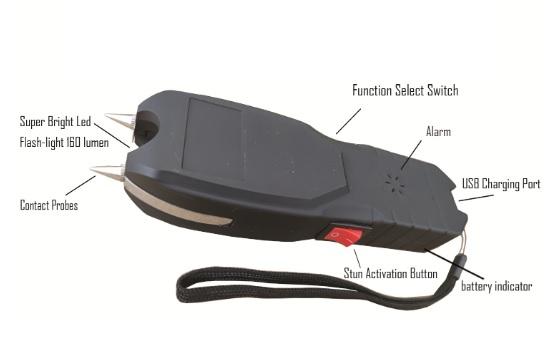Table of Contents
- Understanding the Importance of Clean Stun Gun Contacts
- Effective Cleaning Techniques for Longevity and Reliability
- Preventative Measures to Avoid Contact Corrosion and Wear
- Regular Inspection and Maintenance Schedule for Consistent Performance
- The Conclusion
Understanding the Importance of Clean Stun Gun Contacts
Maintaining pristine contacts on your stun gun is crucial for ensuring its reliability and effective performance when you need it most. Over time, the contacts can accumulate dirt, oils, and oxidation, which significantly reduce the electrical conductivity and overall power output. Dirty or corroded contacts may cause the device to misfire or deliver a weaker charge, compromising your safety. By keeping the contact points clean, you not only prolong the lifespan of your stun gun but also maintain consistent functionality, giving you peace of mind in emergency situations.
To keep contacts in top condition, focus on routine care with these essential steps:
- Regular inspection: Check for signs of rust, debris, or discoloration.
- Gentle cleaning: Use a cotton swab and isopropyl alcohol to carefully wipe the contact points without damaging the surface.
- Proper storage: Store your stun gun in a dry place to prevent moisture buildup that accelerates corrosion.
- Avoid harsh chemicals: These can degrade the metal contacts and reduce efficacy.
Effective Cleaning Techniques for Longevity and Reliability
To ensure your stun gun’s contacts remain functional and reliable, meticulous cleaning is crucial. Begin by using a soft brush or a cotton swab lightly moistened with isopropyl alcohol to gently remove any dirt, dust, or residue that may accumulate on the contact points. Avoid abrasive materials, as they can scratch or damage the delicate metal surfaces. Additionally, incorporating a contact cleaner designed for electrical components can break down stubborn corrosion or oxidation, restoring optimal conductivity. Remember to power off the device and remove any batteries before cleaning to avoid unnecessary electrical hazards.
Consistency is key in maintaining peak performance. Develop a routine that includes inspecting the contacts for signs of wear or pitting, as these can affect the stun gun’s efficacy. Incorporate the following best practices:
- Use non-abrasive tools: microfiber cloths and soft brushes to prevent damage
- Apply contact protectants: specialized sprays that prevent oxidation and build-up
- Store the device properly: in dry, cool environments to minimize moisture and corrosion risks
Preventative Measures to Avoid Contact Corrosion and Wear
Maintaining the integrity of stun gun contacts requires regular attention and a proactive approach to prevent corrosion and wear. First, ensure the contacts are kept clean and dry at all times. Moisture and dirt are the primary culprits that accelerate oxidation and wear on metal components. Use a soft, lint-free cloth to gently wipe the contacts after every use or inspection. Avoid harsh chemicals; instead, opt for isopropyl alcohol, which effectively removes residue without damaging the metal surface. Furthermore, storing the stun gun in a cool, dry environment reduces exposure to humidity, which can speed up corrosion.
In addition to regular cleaning, consider protective coatings or contact protectors designed specifically for conductive metals. Applying these can create a barrier against environmental contaminants. Additionally, avoid excessive mechanical stress on the contacts by minimizing rough handling or frequent disassembly, which can cause micro abrasions and wear. When not in use for extended periods, disconnect the battery if removable, to prevent potential electrolyte leakage that can corrode contacts. By incorporating these routine habits, you’ll preserve the functionality and longevity of your stun gun’s contacts, ensuring it performs reliably when needed.
Regular Inspection and Maintenance Schedule for Consistent Performance
Consistent performance starts with a disciplined routine of inspections and maintenance. Focus on checking the stun gun contacts for any signs of wear, corrosion, or residue buildup at least once a month. Use a soft, dry cloth or a cotton swab dipped in isopropyl alcohol to gently clean the contacts-this removes oils and debris that can impede electrical flow. Avoid abrasive materials, as they may damage the delicate metal surfaces. Keeping the contacts dry and free from contaminants ensures maximum conductivity and reliable discharge every time you need it.
To streamline your maintenance routine, consider the following checklist:
- Inspect contacts visually for discoloration or pitting.
- Clean contacts with alcohol-based solutions.
- Check for secure contact alignment and adjust if necessary.
- Test the stun gun’s discharge strength regularly.
- Store the device in a dry, temperature-controlled environment.
Adhering to this schedule not only prolongs the life of your stun gun but also guarantees operational readiness, giving you peace of mind and optimal defense whenever it matters most.
The Conclusion
Maintaining your stun gun contacts is a simple yet crucial step to ensure your device performs reliably when you need it most. By regularly cleaning, inspecting, and protecting the contacts from corrosion and damage, you can extend the lifespan of your stun gun and maintain its effectiveness. Remember, a little routine care goes a long way in keeping your self-defense tool in top shape. Stay vigilant, stay prepared, and prioritize safety by making contact maintenance a regular part of your stun gun upkeep.Check Our Other Blogs
- StunGun – Your Trusted Source for Stun Guns, Laws, and Self-Defense Tips
- PepperSprayLaws – Your Trusted Resource for Pepper Spray Information
- StunGunLaws – Your Trusted Guide to Stun Gun Legality and Safety





